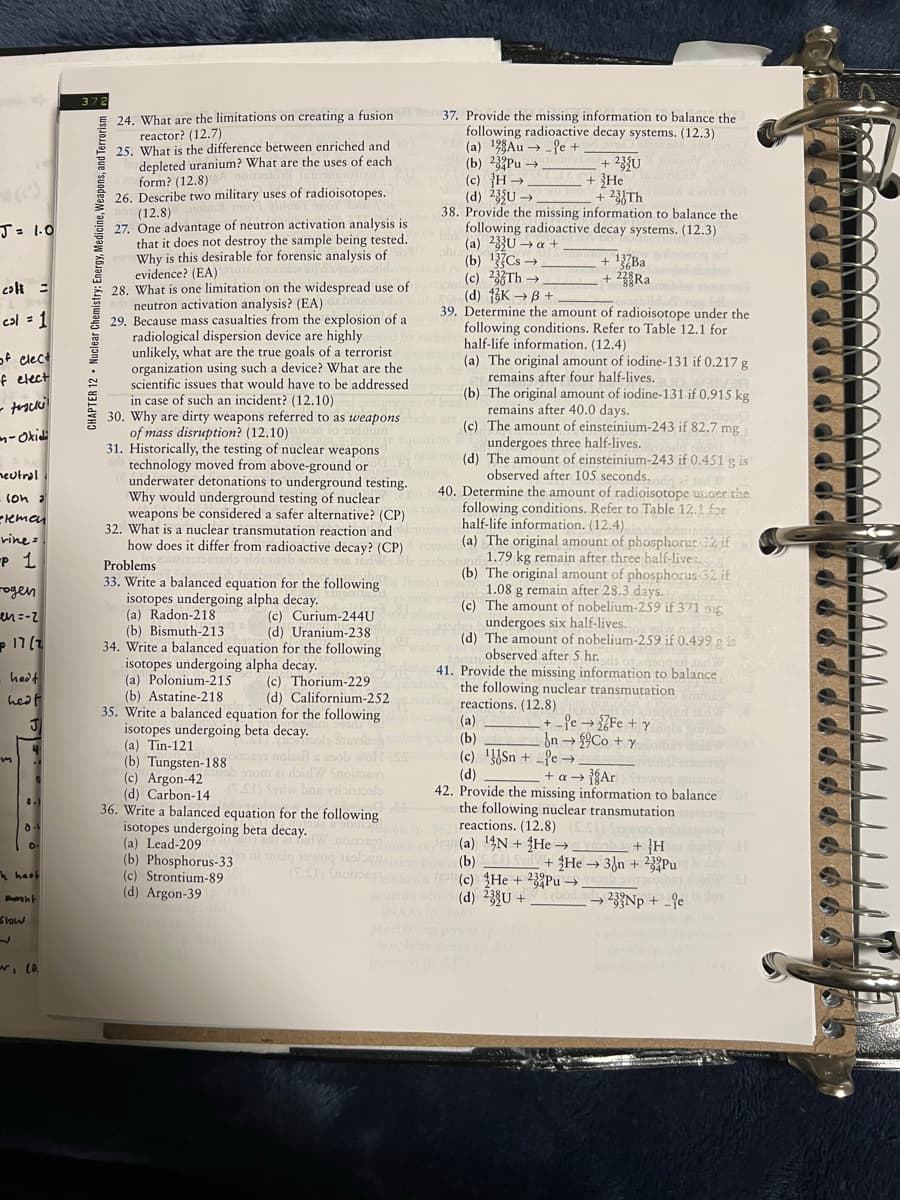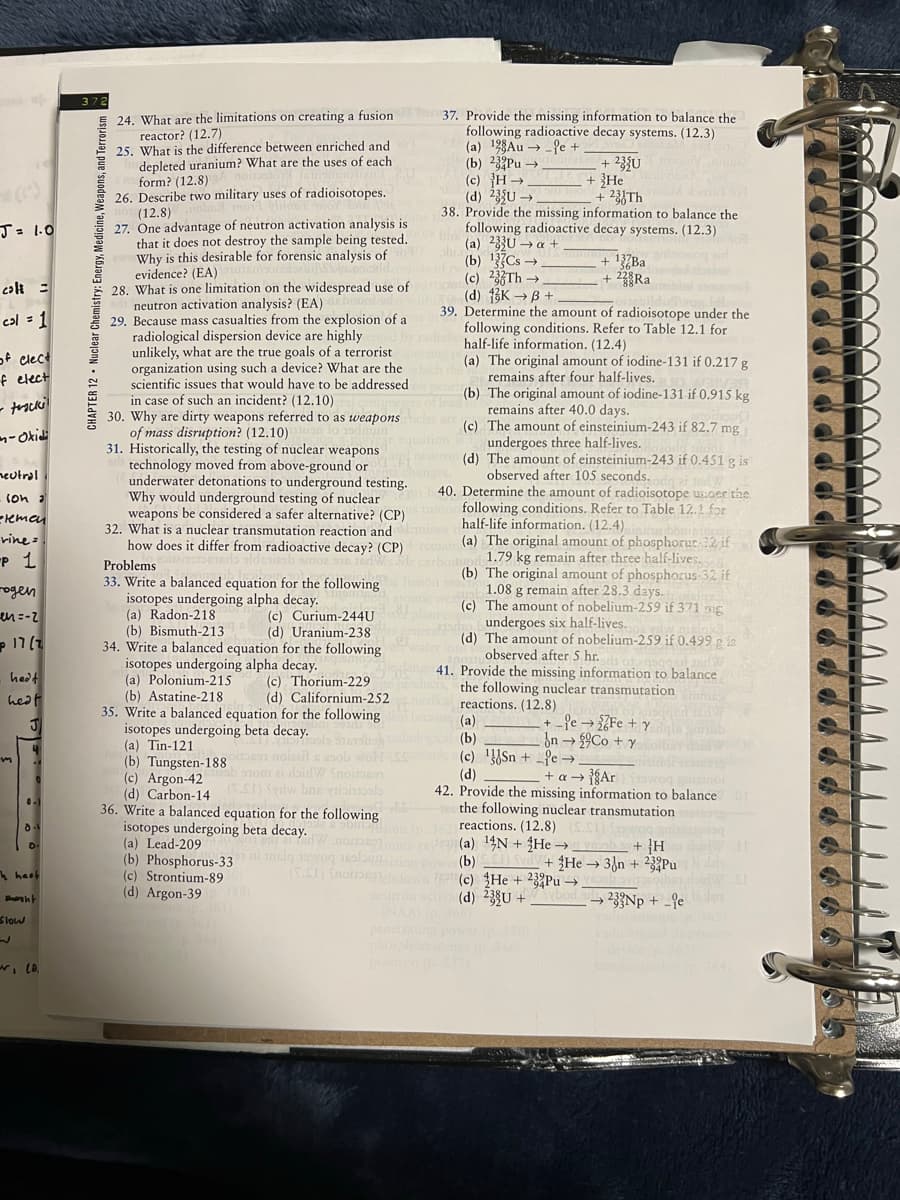37. Provide the missing information to balance the following radioactive decay systems. (12.3) (a) 198Au → -Pe + (b) 23Pu → (c) H→ (d) 23U → + 23{U + }He + 23{Th ->
37. Provide the missing information to balance the following radioactive decay systems. (12.3) (a) 198Au → -Pe + (b) 23Pu → (c) H→ (d) 23U → + 23{U + }He + 23{Th ->
Chemistry: Principles and Reactions
8th Edition
ISBN:9781305079373
Author:William L. Masterton, Cecile N. Hurley
Publisher:William L. Masterton, Cecile N. Hurley
Chapter18: Nuclear Reactions
Section: Chapter Questions
Problem 43QAP
Related questions
Question
Question number 27, 29,31,33,35,37,39,41,43,45

Transcribed Image Text:5 24. What are the limitations on creating a fusion
reactor? (12.7)
25. What is the difference between enriched and
depleted uranium? What are the uses of each
form? (12.8)
26. Describe two military uses of radioisotopes.
(12.8)
27. One advantage of neutron activation analysis is
that it does not destroy the sample being tested.
Why is this desirable for forensic analysis of
evidence? (EA)
28. What is one limitation on the widespread use of
neutron activation analysis? (EA)
29. Because mass casualties from the explosion of a
radiological dispersion device are highly
unlikely, what are the true goals of a terrorist
organization using such a device? What are the
scientific issues that would have to be addressed
a case of such an incident? (12.10)
30. Why are dirty weapons
of mass disruption? (12.10)
31. Historically, the testing of nuclear weapons
technology moved from above-ground or
underwater detonations to underground testing.
Why would underground testing of nuclear
weapons be considered a safer alternative? (CP)
32. What is a nuclear transmutation reaction and
how does it differ from radioactive decay? (CP)
37. Provide the missing information to balance the
following radioactive decay systems. (12.3)
(a) 128Au → _fe +
(b) 23Pu →
(c) }H
(d) 235U →
38. Provide the missing information to balance the
following radioactive decay systems. (12.3)
(a) 33U → a +
(b) 13Cs →
(c) 23Th →
(d) 3K →B +
39. Determine the amount of radioisotope under the
following conditions. Refer to Table 12.1 for
half-life information. (12.4)
(a) The original amount of iodine-131 if 0.217 g
remains after four half-lives.
(b) The original amount of iodine-131 if 0.915 kg
remains after 40.0 days.
le) The amount of einsteinium-243 if 82.7 mg
+ 23{U
+ }He
+ 23{Th
J=1.0
+ 22°Ra
colt =
cal = 1
of clec
f elect
in
referred to as
weapons
n-Okidi
undergoes three half-lives.
(d) The amount of einsteinium-243 if 0.451 g is
observed after 105 seconds.
40. Determine the amount of radioisotope usder the
following conditions. Refer to Table 12.1 for
half-life information. (12.4).
(a) The original amount of phosphorue 12 if
1.79 kg remain after three half-lives.
(b) The original amount of phosphorus-32 if
neutral
(on a
reman
vine :
P 1
Problems
33. Write a balanced equation for the following
isotopes undergoing alpha decay.
(a) Radon-218
(b) Bismuth-213
34. Write a balanced equation for the following
ogen
en=-2
g remain after 28.3 days.
The amount of nobeljum-259 if 371 ng
undergoes
(d) The amount of nobelium-259 if 0.499g is
observed after 5 hr.
41. Provide the missing information to balance
the following nuclear transmutation
reactions. (12.8)
(a)
(b)
(c) }{Sn + fe →
(d)
42. Provide the missing information to balance
the following nuclear transmutation
reactions. (12.8)
(a) 14N + He →
(b)
(c) He + 23Pu →
(d) 23U +
(c) Curium-244U
(d) Uranium-238
six half-lives.
)mו <
Isotopes undergoing alpha decay.
(a) Polonium-215
(b) Astatine-218
35. Write a balanced equation for the following
hedt
(c) Thorium-229
(d) Californium-252
heat
Pe → 7Fe + y
ốn → £9C0 + y
isotopes undergoing beta decay.
(a) Tin-121
(b) Tungsten-188
(c) Argon-42
(d) Carbon-14
36. Write a balanced equation for the following
isotopes undergoing beta decay.
(a) Lead-209
(b) Phosphorus-33
(c) Strontium-89
(d) Argon-39
STom ai daidW Snoitoson
+ a → {Ar
Syrlw bne valohals
+ }H
He 3{n + 233Pu
4 heof
noio
233Np + -9e
Slow
penet
CHAPTER 12 · Nuclear Chemistry: Energy, Medicine, Weapons, and Terrorism

Transcribed Image Text:5 24. What are the limitations on creating a fusion
reactor? (12.7)
25. What is the difference between enriched and
depleted uranium? What are the uses of each
form? (12.8)
26. Describe two military uses of radioisotopes.
(12.8)
27. One advantage of neutron activation analysis is
that it does not destroy the sample being tested.
Why is this desirable for forensic analysis of
evidence? (EA)
28. What is one limitation on the widespread use of
neutron activation analysis? (EA)
29. Because mass casualties from the explosion of a
radiological dispersion device are highly
unlikely, what are the true goals of a terrorist
organization using such a device? What are the
scientific issues that would have to be addressed
a case of such an incident? (12.10)
30. Why are dirty weapons
of mass disruption? (12.10)
31. Historically, the testing of nuclear weapons
technology moved from above-ground or
underwater detonations to underground testing.
Why would underground testing of nuclear
weapons be considered a safer alternative? (CP)
32. What is a nuclear transmutation reaction and
how does it differ from radioactive decay? (CP)
37. Provide the missing information to balance the
following radioactive decay systems. (12.3)
(a) 128Au → _fe +
(b) 23Pu →
(c) }H
(d) 235U →
38. Provide the missing information to balance the
following radioactive decay systems. (12.3)
(a) 33U → a +
(b) 13Cs →
(c) 23Th →
(d) 3K →B +
39. Determine the amount of radioisotope under the
following conditions. Refer to Table 12.1 for
half-life information. (12.4)
(a) The original amount of iodine-131 if 0.217 g
remains after four half-lives.
(b) The original amount of iodine-131 if 0.915 kg
remains after 40.0 days.
le) The amount of einsteinium-243 if 82.7 mg
+ 23{U
+ }He
+ 23{Th
J=1.0
+ 22°Ra
colt =
cal = 1
of clec
f elect
in
referred to as
weapons
n-Okidi
undergoes three half-lives.
(d) The amount of einsteinium-243 if 0.451 g is
observed after 105 seconds.
40. Determine the amount of radioisotope usder the
following conditions. Refer to Table 12.1 for
half-life information. (12.4).
(a) The original amount of phosphorue 12 if
1.79 kg remain after three half-lives.
(b) The original amount of phosphorus-32 if
neutral
(on a
reman
vine :
P 1
Problems
33. Write a balanced equation for the following
isotopes undergoing alpha decay.
(a) Radon-218
(b) Bismuth-213
34. Write a balanced equation for the following
ogen
en=-2
g remain after 28.3 days.
The amount of nobeljum-259 if 371 ng
undergoes
(d) The amount of nobelium-259 if 0.499g is
observed after 5 hr.
41. Provide the missing information to balance
the following nuclear transmutation
reactions. (12.8)
(a)
(b)
(c) }{Sn + fe →
(d)
42. Provide the missing information to balance
the following nuclear transmutation
reactions. (12.8)
(a) 14N + He →
(b)
(c) He + 23Pu →
(d) 23U +
(c) Curium-244U
(d) Uranium-238
six half-lives.
)mו <
Isotopes undergoing alpha decay.
(a) Polonium-215
(b) Astatine-218
35. Write a balanced equation for the following
hedt
(c) Thorium-229
(d) Californium-252
heat
Pe → 7Fe + y
ốn → £9C0 + y
isotopes undergoing beta decay.
(a) Tin-121
(b) Tungsten-188
(c) Argon-42
(d) Carbon-14
36. Write a balanced equation for the following
isotopes undergoing beta decay.
(a) Lead-209
(b) Phosphorus-33
(c) Strontium-89
(d) Argon-39
STom ai daidW Snoitoson
+ a → {Ar
Syrlw bne valohals
+ }H
He 3{n + 233Pu
4 heof
noio
233Np + -9e
Slow
penet
CHAPTER 12 · Nuclear Chemistry: Energy, Medicine, Weapons, and Terrorism
Expert Solution
This question has been solved!
Explore an expertly crafted, step-by-step solution for a thorough understanding of key concepts.
Step by step
Solved in 3 steps with 1 images

Knowledge Booster
Learn more about
Need a deep-dive on the concept behind this application? Look no further. Learn more about this topic, chemistry and related others by exploring similar questions and additional content below.Recommended textbooks for you

Chemistry: Principles and Reactions
Chemistry
ISBN:
9781305079373
Author:
William L. Masterton, Cecile N. Hurley
Publisher:
Cengage Learning

Chemistry: Principles and Reactions
Chemistry
ISBN:
9781305079373
Author:
William L. Masterton, Cecile N. Hurley
Publisher:
Cengage Learning